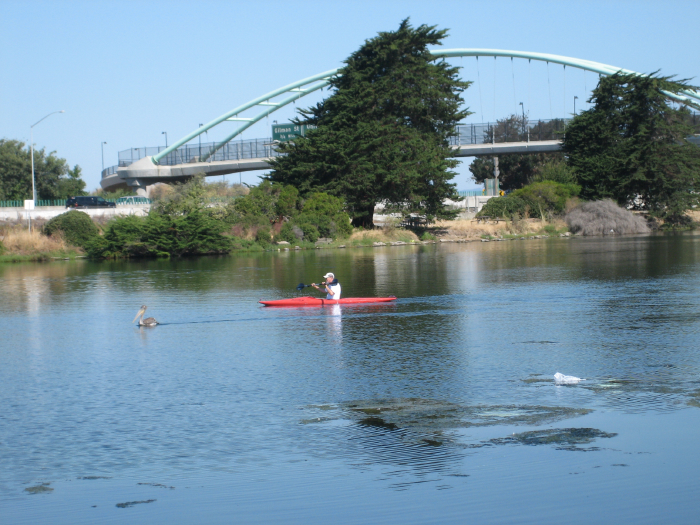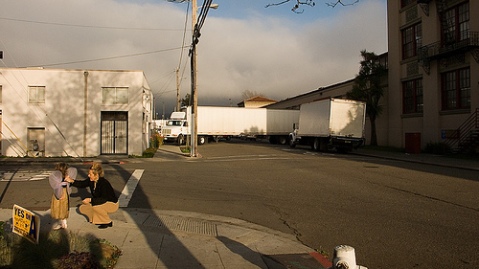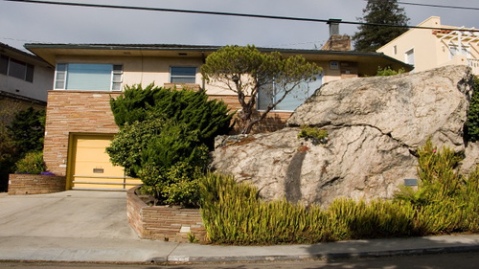Picking favorite parks is tough when there are over 50 to choose from in Berkeley! Here my choices are based on the parks that I found most enjoyable as a walker. My selections would be different if I was picking what I think are the most successful parks from an urban planning standpoint (i.e., design and layout, placement, activities, safety, etc.). Again, in no particular order:
John Hinkel Park: Entering this park for the first time, I had one of the many moments on this walk where I decided that it was worthwhile to walk each and every street. Unless I lived near this park, I might not have realized it was there. I had the feeling of being far away from anything urban — creeks flowing, lots of vegetation, and crisscrossing trails through the park. Also of interest here is the amphitheater that has been the site of the Berkeley Shakespeare Festival.
Rock Parks: There are several rock parks in the Thousand Oaks area, which can be combined with several of the Berkeley paths for a very nice walk. This is a great place to bring visitors to show them a unique part of Berkeley. One of my blog entries from last year has a few more details about the rock parks, and the Berkeley Path Wanderers has a nice suggested route, with history, for visiting these parks.
Live Oak Park: This is a great park to plan into a walk as a place to take a break and look around for awhile. It includes a restored stone fireplace in the picnic area, the Berkeley Art Center, a nice places to stroll along the creek and through the trees. From Downtown Berkeley BART, walk north on Shattuck and on to Berryman Path to walk through the park. Just a few blocks from Live Oak Park is the Berkeley Rose Garden and Codornices Park (with a waterfall!), which make a nice combined walk.
Ohlone Park: This park, which extends from Sacramento St. to Milvia St., between Hearst and Delaware, offers a lot to look at for the walker: playing fields, basketball court, community garden, off-leash dog area, an Ohlone history mural, and play areas. From North Berkeley BART (crossing Sacramento at Delaware), it’s a nice flat stroll along the Ohlone Greenway paralleling Ohlone Park. At the end of the Greenway, continue to straight for a couple of blocks to visit the UC Berkeley campus, or turn right on Shattuck to get to the downtown Berkeley BART.
Strawberry Creek Park: I really enjoy walking through this park because it affords an opportunity to visit the Strawberry Creek Design Center (more on this in a separate Highlights post). The park also include native plants, and recreation areas and courts. The Santa Fe Right of Way runs through this park, which will be particularly nice for walking once a connecting block is opened between University and Addison through the Montessori school. Next to this park is the Berkeley Lawn Bowling Green, which offers free lessons on Wednesday and Saturday mornings. For a Saturday morning walk from Downtown Berkeley BART, head from BART through the Saturday Farmer’s Market (starts at 10 a.m.) on Center Street, cross southwest through Cesar Chavez Park to Allston, continue Allston past Presentation Park and across Sacramento, left at Acton to the Lawn Bowling Green to view the bowlers in action, right on Bancroft and right into Strawberry Creek Park at the Santa Fe Right of Way path. This can also be combined with a visit to Ohlone Park (listed above) to make a loop back to where you started.
King School Park: For the same reasons that I like Hopkins Street, which I mentioned in my commercial area favorites), I enjoy walking past the nearby King School Park. In the early evening and on weekends, this park is busy with people playing tennis, jogging on the track, walking dogs, and chatting with neighbors. A nice loop walk that includes this park is Sacramento, Hopkins, The Alameda/MLK, and Rose streets. You’ll see the King School Park, the North Berkeley Public Library, the Edible Schoolyard (at King School), and the Hopkins Street commercial district.
John Muir School Park: Another school park, but this one is quite different than King School. The best way to explore this park is by walking the Oakridge Path between Claremont and Domingo avenues. Harwood (Claremont) Creek runs through the park, and you’ll see native plantings and restoration work done by the children from the school. There’s also a very nice school vegetable garden here.
Berkeley Marina (includes Shorebird Park, Cesar Chavez Park, Horseshoe Park, and the Adventure Playground): Technically this is divided into a few parks, but most people will visit through more than one of them on a trip out there. Some highlights include a straw bale environmental education building (Shorebird Park), tools and building actitivies for children (Adventure Playground), great views on the loop around Cesar Chavez park, and the long fishing pier (which can be walked out to the end). If you are up for a long but flat walk, take the I-80 pedestrian/bike bridge (accessed at the foot of Addison Street) over to the Marina. On the Marina side of the bridge is the Sea Breeze Cafe, a good store for some coffee or refreshments for the walk. A visit to the Berkeley Marina would be an ideal outing for someone coming into Berkeley on Amtrak, whose station is situated a block from the bike bridge under the University Avenue overpass.








